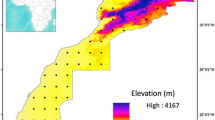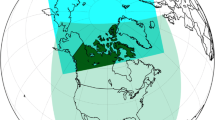Abstract
Global Circulation Models (GCMs) and Regional Climate Models (RCMs) are fundamental tools for investigating climate change and its impact. This study focuses on evaluation the ability of two Regional Climate Models (RCMs), REMO2015 and RegCM4-7, to simulate minimum and maximum temperature as well as monthly precipitation in Northwestern Iraq. The evaluation is based on comparisons with observed data from four key stations in the region. Both the regional models, REMO2015 and RegCM4-7, are driven by three GCMs, so the number of models evaluated is six GCM-RCM combination models. The performance of the six GCM-RCM model outputs was evaluated against observed data using a suite of statistical criteria: Bias Percent (PBIAS), Mean Absolute Error (MAE), Root Mean Square Error (RMSE), Correlation Coefficient (R), and Cumulative Distribution Function (CDF). Additionally, the Innovative Test (IT) was employed to analyze trends in both annual and monthly precipitation data. Also, Bias correction was employed the “Linear scaling: method to correct temperature and “Distribution Mapping” method for monthly precipitation. In general, the six models exhibited better performance in simulating minimum and maximum temperature than monthly precipitation. An interesting finding is that all six models exhibited similar behavior in simulating maximum temperature across all stations. Statistical criteria values revealed that the NCC-RegCM4-7 model produces the best results for minimum temperature simulation. Meanwhile for in maximum temperature, both MOHC-REMO2015 and NCC-REMO2015 emerged as the top performers. Additionally, MIROC-RegCM4-7 demonstrated the greatest skill in capturing t trends in the observed data, closely matching the trends measured at the studied stations. The application of the linear scaling method effectively addressed the biases present in the raw temperature data from the six GCM-RCM combinations. This correlation resulted in reduced MAE and RMSE values for both minimum and maximum temperatures. Similarly, the DM method successfully removed biases in the monthly precipitation simulation from all six models.







Similar content being viewed by others
Data availability
Data cannot be made publicly available; readers should contact the corresponding author for details.
References
Abbas N, Wasimi SA, Al-Ansari N (2016a) Assessment of climate change impacts on water resources of khabour in Kurdistan, Iraq using swat model. J Environ Hydrol 24:1–10. https://doi.org/10.4236/eng.2016.810064
Abbas SA, Xuan Y, Al-rammahi AH, Addab HF (2022) A comparison study of observed and the CMIP5 modelled precipitation over Iraq 1941–2005. Atmosphere (Basel) 13:1–18. https://doi.org/10.3390/atmos13111869
Abbas N, Wasimi SA, Al-Ansari N (2016b) Impacts of climate change on water resources in Diyala River Basin, Iraq. J Civil Eng Archit 10:1059–1074. https://doi.org/10.17265/1934-7359/2016.09.009
Abbasa N, Wasimia SA, Al-ansari N (2016) Assessment of climate change impacts on water resources of Al-Adhaim, Iraq using SWAT model. Sci Res Publish 8:716–732. https://doi.org/10.4236/eng.2016.810065
Abbasian M, Moghim S, Abrishamch A (2019) Performance of the general circulation models in simulating temperature and precipitation over Iran. Theor Appl Climatol 135:1465–1483. https://doi.org/10.1007/s00704-018-2456-y
Al-ansari N, Abdellatif M, Ali SS, Knutsson S (2014) Long term effect of climate change on rainfall in northwest Iraq Long term effect of climate change on rainfall in northwest Iraq. Cent Eur J Eng 4:250–263. https://doi.org/10.2478/s13531-013-0151-4
Ali R, Kuriqi A, Abubaker SR, Kisi O (2019) Long-term trends and seasonality detection of the observed flow in Yangtze river using Mann-Kendall and Sen’s innovative Trend Method. Water (Basel) 11(1855):1–17. https://doi.org/10.3390/w11091855
Bayissa Y, Melesse A, Bhat M et al (2021) Evaluation of regional climate models (RCMs) using precipitation and temperature-based climatic indices: A case study of Florida, USA. Water (Switzerland) 13:1–22. https://doi.org/10.3390/w13172411
Bentsen M, Bethke I, Debernard JB et al (2013) The Norwegian Earth System Model, NorESM1-M – part 1: description and basic evaluation of the physical climate. Geosci Model Dev 6:687–720. https://doi.org/10.5194/gmd-6-687-2013
Brighenti TM, Gassman PW, Gutowski WJ, Thompson JR (2023) Assessing the influence of a bias correction method on future climate scenarios using SWAT as an impact model indicator. Water (Switzerland) 15:1–15. https://doi.org/10.3390/w15040750
Christensen JH, Boberg F, Christensen OB, Lucas-picher P (2008) On the need for bias correction of regional climate change projections of temperature and precipitation. Geophys Res Lett 35:1–6. https://doi.org/10.1029/2008GL035694
Collins WJ, Bellouin N, Doutriaux-Boucher M et al (2011) Development and evaluation of an Earth-System model - HadGEM2. Geosci Model Dev 4:1051–1075. https://doi.org/10.5194/gmd-4-1051-2011
Demissie TA, Sime CH (2021) Assessment of the performance of CORDEX regional climate models in simulating rainfall and air temperature over southwest Ethiopia. Heliyon 7. https://doi.org/10.1016/j.heliyon.2021.e07791
Fang GH, Yang J, Chen YN, Zammit C (2015) Comparing bias correction methods in downscaling meteorological variables for a hydrologic impact study in an arid area in China. Hydrol Earth Syst Sci 2547–2559. 10.5194/hess-19-2547-2015
Gedefaw M, Yan D, Wang H et al (2018) Innovative trend analysis of annual and seasonal rainfall variability in Amhara regional state, Ethiopia. Atmosphere (Basel) 326:1–10. https://doi.org/10.3390/atmos9090326
Ghulami M, Gourbesville P, Audra P, Shie-Yui L (2022) Performance evaluation of CORDEX South Asia models for projections of precipitation over the Kabul basin, Afghanistan. LHB Hydrosci J 108:1-11. https://doi.org/10.1080/27678490.2022.2095936
Giorgetta MA, Jungclaus J, Reick CH et al (2013) Climate and carbon cycle changes from 1850 to 2100 in MPI-ESM simulations for the Coupled Model Intercomparison Project phase 5. J Adv Model Earth Syst 5:572–597. https://doi.org/10.1002/jame.20038
Giorgi F (2019) Thirty years of regional climate modeling : where are we and where are we going next ? J Geophys Res Atmos 124:5696–5723. https://doi.org/10.1029/2018JD030094
Giorgi F, Jones C, Asrar GR (2009) Addressing climate information needs at the regional level: the CORDEX framework. WMO Bull 58:175–183
Giorgi F, Coppola E, Solmon F et al (2012) RegCM4: model description and preliminary tests over multiple CORDEX domains. Clim Res 52:7–29. https://doi.org/10.3354/cr01018
Guo D, Sun J, Yu E (2018) Evaluation of CORDEX regional climate models in simulating temperature and precipitation over the Tibetan Plateau. Atmos Ocean Sci Lett 2834:1–9. https://doi.org/10.1080/16742834.2018.1451725
Hajani E, Klari Z (2022) Trends analysis in rainfall data series in Duhok city, Kurdistan region, Iraq. Model Earth Syst Environ 8:4177–4190. https://doi.org/10.1007/s40808-022-01354-1
Hounguè NR, Almoradie ADS, Evers M (2022) A multi criteria decision analysis approach for regional climate model selection and future climate assessment in the Mono River Basin, Benin and Togo. Atmosphere (Basel) 13:1–19. https://doi.org/10.3390/atmos13091471
Ilori OW, Balogun IA (2022) Evaluating the performance of new CORDEX - Africa regional climate models in simulating West African rainfall. Model Earth Syst Environ 8:665–688. https://doi.org/10.1007/s40808-021-01084-w
Jenifer MA, Jha MK (2021) Assessment of precipitation trends and its implications in the semi-arid region of Southern India. Environ Chall 5:1–16. https://doi.org/10.1016/j.envc.2021.100269
Jones C, Giorgi F, Asrar G (2011) The Coordinated Regional Downscaling Experiment: CORDEX An international downscaling link to CMIP5. CLIVAR Exchanges 16:34–40
Khayyun T, Alwan IA, Hayder AM (2020) Selection of suitable precipitation CMIP-5 sets of GCMs for Iraq using a symmetrical uncertainty filter. In: 3rd international conference on engineering sciences 671:1–12. https://doi.org/10.1088/1757-899X/671/1/012013
Kim J, Waliser DE, Mattmann CA et al (2014) Evaluation of the CORDEX-Africa multi-RCM hindcast: systematic model errors. Clim Dyn 42:1189–1202. https://doi.org/10.1007/s00382-013-1751-7
Kim KB, Kwon H, Han D (2016) Precipitation ensembles conforming to natural variations derived from a regional climate model using a new bias correction scheme. Hydrol Earth Syst Sci 20:2019–2034. https://doi.org/10.5194/hess-20-2019-2016
Kisembe J, Favre A, Dosio A et al (2019) Evaluation of rainfall simulations over Uganda in CORDEX regional climate models. Theor Appl Climatol 137:1117–1134. https://doi.org/10.1007/s00704-018-2643-x
Kjellström E, Boberg F, Castro M, Christensen JH (2010) Daily and monthly temperature and precipitation statistics as performance indicators for regional climate models. Clim Res 44:135–150. https://doi.org/10.3354/cr00932
Liu S (2023) Regional Climate Simulation Ensembles within CORDEX-EA Framework over the loess plateau: evaluation and future projections. Atmosphere (Basel) 14. https://doi.org/10.3390/atmos14091435
Malik A, Kumar A, Guhathakurta P, Kisi O (2019) Spatial-temporal trend analysis of seasonal and annual rainfall (1966–2015) using innovative trend analysis method with significance test. Arab J Geosci 12(328). https://doi.org/10.1007/s12517-019-4454-5l
Marak JDK, Sarma AK, Bhattacharjya RK (2020) Innovative trend analysis of spatial and temporal rainfall variations in Umiam and Umtru watersheds in Meghalaya, India. Theor Appl Climatol 142:1397–1412. https://doi.org/10.1007/s00704-020-03383-1
Mendez M, Maathuis B, Hein-Griggs D, Alvarado-Gamboa LF (2020) Performance evaluation of bias correction methods for climate change monthly precipitation projections over Costa Rica. Water (Switzerland) 12. https://doi.org/10.3390/w12020482
Meng J, Li L, Hao Z et al (2014) Suitability of TRMM satellite rainfall in driving a distributed hydrological model in the source region of Yellow River. J Hydrol (Amst) 509:320–332. https://doi.org/10.1016/j.jhydrol.2013.11.049
Mengistu AG, Woldesenbet TA, Dile YT (2021) Evaluation of the performance of bias-corrected CORDEX regional climate models in reproducing Baro-Akobo basin climate. Theor Appl Climatol 144:751–767. https://doi.org/10.1007/s00704-021-03552-w/Published
Osman Y, Abdellatif M, Al-Ansari N et al (2017) Climate change and future precipitation in an arid environment of the Middle East: CASE STUDY of Iraq. J Environ Hydrol 25:1–18
Osman Y, Al-Ansari N, Abdellatif M (2019) Climate change model as a decision support tool for water resources management in northern Iraq: a case study of Greater Zab River. J Water Clim Change 10:197–209. https://doi.org/10.2166/wcc.2017.083
Rasheed AMM (2010) Analysis of rainfall drought periods in the north of Iraq using Standard Precipitation Index (SPI). Al-Rafidain Eng 18:60–72. https://doi.org/10.33899/rengj.2010.28187
Remedio AR, Teichmann C, Buntemeyer L et al (2019) Evaluation of new CORDEX simulations using an updated köppen-trewartha climate classification. Atmosphere (Basel) 10:1–25. https://doi.org/10.3390/atmos10110726
Res C, Shabalova M V, Deursen WPA Van, Buishand TA (2003) Assessing future discharge of the river Rhine using regional climate model integrations and a hydrological model. Climate Research 23:233–246. https://doi.org/10.3354/cr023233
Seager R, Vecchi GA (2010) Greenhouse warming and the 21st century hydroclimate of southwestern North America. Proc Natl Acad Sci USA 107:21277–21282 SPECIAL. https://doi.org/10.1073/pnas.0910856107
Şen Z (2017) Innovative trend significance test and applications. Theor Appl Climatol 127:939–947. https://doi.org/10.1007/s00704-015-1681-x
Şen Z (2012) Innovative trend analysis methodology. J Hydrol Eng 1042–1046. https://doi.org/10.1061/(ASCE)HE.1943-5584.0000556
Teichmann C, Jacob D, Remedio AR et al (2021) Assessing mean climate change signals in the global CORDEX-CORE ensemble. Clim Dyn 57:1269–1292. https://doi.org/10.1007/s00382-020-05494-x
Teutschbein C, Seibert J (2010) Regional climate models for hydrological impact studies at the catchment scale : a review of recent modeling strategies. Geogr Compass 4(7):834–860. https://doi.org/10.1111/j.1749-8198.2010.00357
Teutschbein C, Seibert J (2013) Is bias correction of regional climate model (RCM) simulations possible for non-stationary conditions. Hydrol Earth Syst Sci 17:5061–5077. https://doi.org/10.5194/hess-17-5061-2013
Themeßl MJ, Gobiet A, Heinrich G (2012) Empirical-statistical downscaling and error correction of regional climate models and its impact on the climate change signal. Clim Change 112:449–468. https://doi.org/10.1007/s10584-011-0224-4
Top S, Kotova L, De Cruz L et al (2021) Evaluation of regional climate models ALARO-0 and REMO2015 at 0.22° resolution over the CORDEX Central Asia domain. Geosci Model Dev 14:1267–1293. https://doi.org/10.5194/gmd-14-1267-2021
Watanabe M, Suzuki T, O’Ishi R et al (2010) Improved climate simulation by MIROC5: Mean states, variability, and climate sensitivity. J Clim 23:6312–6335. https://doi.org/10.1175/2010JCLI3679.1
Funding
The authors declare that no funds, grants, or other support were received during the preparation of this manuscript.
Author information
Authors and Affiliations
Contributions
All authors contributed to the study’s conception and design. All authors read and approved the final manuscript.
Corresponding author
Ethics declarations
Conflict of interest
The authors have no competing interests to declare that are relevant to the content of this article.
Additional information
Publisher's Note
Springer Nature remains neutral with regard to jurisdictional claims in published maps and institutional affiliations.
Rights and permissions
Springer Nature or its licensor (e.g. a society or other partner) holds exclusive rights to this article under a publishing agreement with the author(s) or other rightsholder(s); author self-archiving of the accepted manuscript version of this article is solely governed by the terms of such publishing agreement and applicable law.
About this article
Cite this article
Al-Hilali, S.S., Hassan, A.A., Moussa, A.M. et al. Performance evaluation of six RCMs for precipitation and temperature in a semi-arid region. Model. Earth Syst. Environ. (2024). https://doi.org/10.1007/s40808-024-02006-2
Received:
Accepted:
Published:
DOI: https://doi.org/10.1007/s40808-024-02006-2




